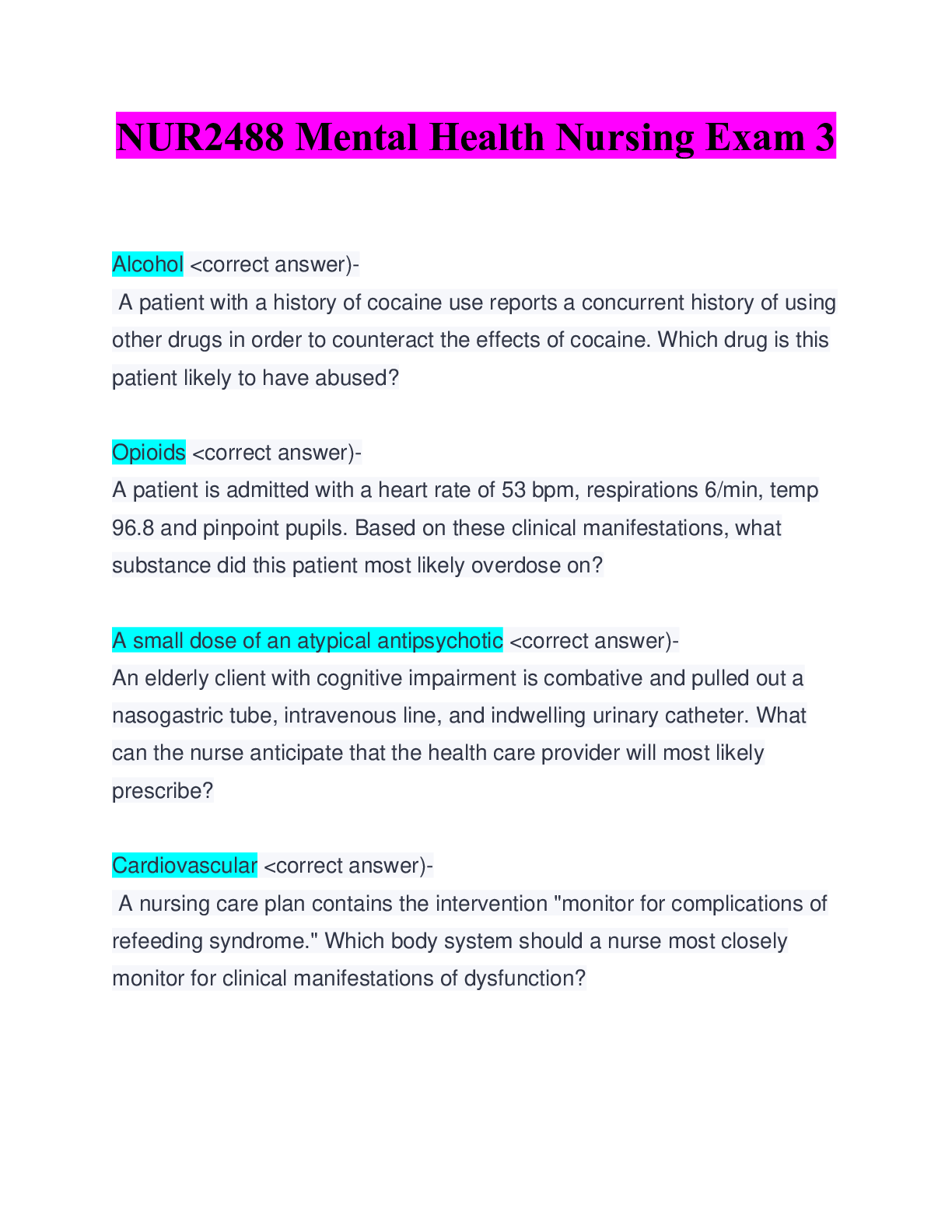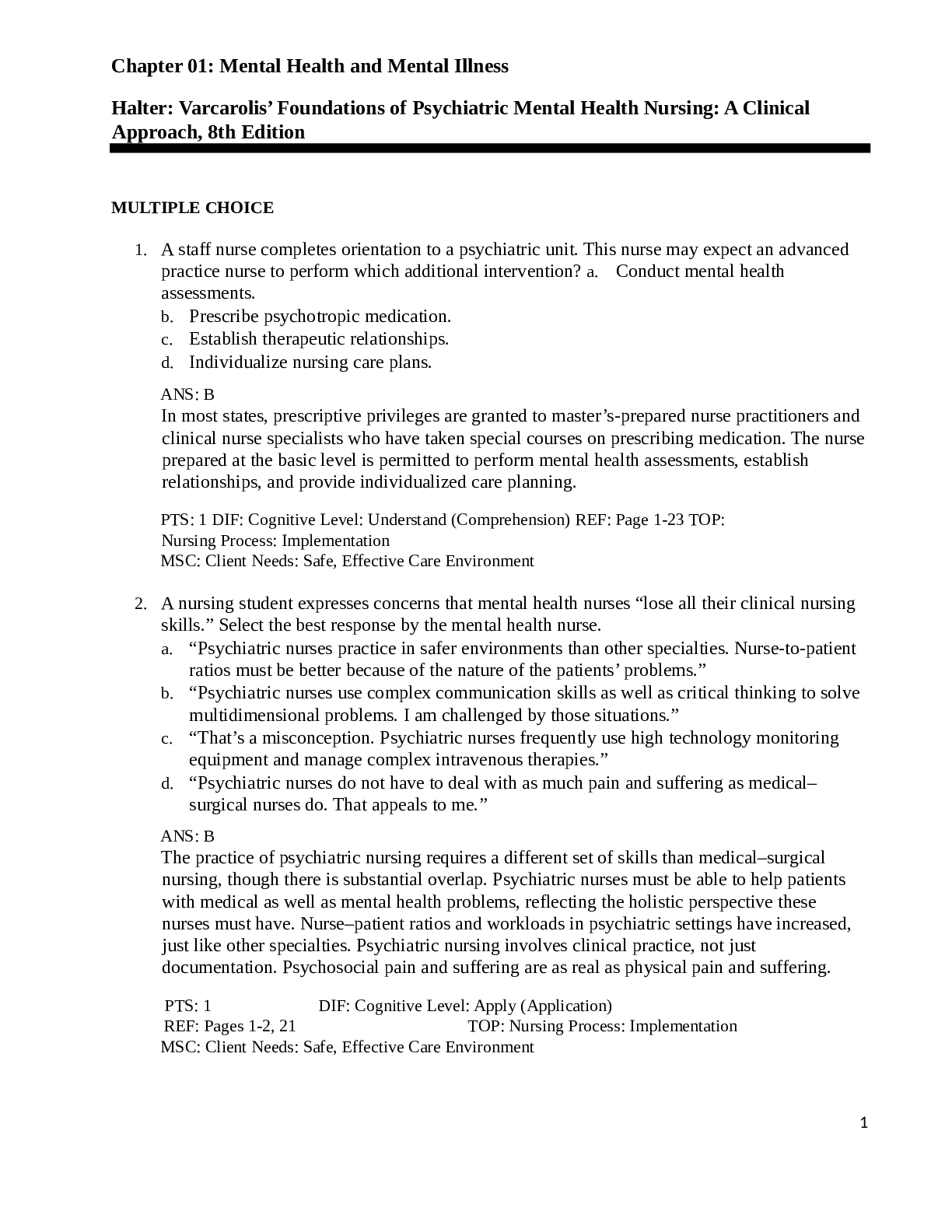*NURSING > EXAM > Chapter 25: Suicide and Nonsuicidal Self-Injury Halter: Varcarolis’ Foundations of Psychiatric Men (All)
Chapter 25: Suicide and Nonsuicidal Self-Injury Halter: Varcarolis’ Foundations of Psychiatric Mental Health Nursing: A Clinical Approach, 8th Edition
Document Content and Description Below
1. An adult outpatient diagnosed with major depressive disorder has a history of several suicide attempts by overdose. Given this patient‘s history and diagnosis, which antidepressant medication w... ould the nurse expect to be prescribed? a. Amitriptyline b. Fluoxetine c. Desipramine d. Tranylcypromine sulfate ANS: B Selective serotonin reuptake inhibitor antidepressants are very safe in overdosage situations, which is not true of the other medications listed. Given this patient‘s history of overdosing, it is important that the medication be as safe as possible in the event of another overdose of prescribed medication. PTS: 1 DIF: Cognitive Level: Analyze (Analysis) REF: Pages 25-25, 26 TOP: Nursing Process: Planning MSC: Client Needs: Physiological Integrity 2. Four individuals have given information about their suicide plans. Which plan evidences the highest suicide risk? a. Turning on the oven and letting gas escape into the apartment during the night b. Cutting the wrists in the bathroom while the spouse reads in the next room c. Overdosing on aspirin with codeine while the spouse is out with friends d. Jumping from a railroad bridge located in a deserted area late at night ANS: D This is a highly lethal method with little opportunity for rescue. The other options are lower lethality methods with higher rescue potential. See relationship to audience response question. PTS: 1 DIF: Cognitive Level: Analyze (Analysis) REF: Pages 25-15, 16 TOP: Nursing Process: Assessment MSC: Client Needs: Psychosocial Integrity 3. Which measure would be considered a form of primary prevention for suicide? a. Psychiatric hospitalization of a suicidal patient b. Referral of a formerly suicidal patient to a support group c. Suicide precautions for 24 hours for newly admitted patients d. Helping school children learn to manage stress and be resilient ANS: D testbanks_and_xanax This measure promotes effective coping and reduces the likelihood that such children will become suicidal later in life. Admissions and suicide precautions are secondary prevention measures. Support group referral is a tertiary prevention measure. PTS: 1 DIF: Cognitive Level: Understand (Comprehension) REF: Pages 25-17, 18, 54 (Box 25-3) TOP: Nursing Process: Implementation MSC: Client Needs: Safe, Effective Care Environment 4. Which change in the brain‘s biochemical function is most associated with suicidal behavior? a. Dopamine excess b. Serotonin deficiency c. Acetylcholine excess d. γ -aminobutyric acid deficiency ANS: B Research suggests that low levels of serotonin may play a role in the decision to commit suicide. The other neurotransmitter alterations have not been implicated in suicidality. PTS: 1 DIF: Cognitive Level: Understand (Comprehension) REF: Page 25-7 TOP: Nursing Process: Assessment MSC: Client Needs: Physiological Integrity 5. A college student who failed two tests cried for hours and then tried to telephone a parent but got no answer. The student then gave several expensive sweaters to a roommate and asked to be left alone for a few hours. Which behavior provides the strongest clue of an impending suicide attempt? a. Calling parents b. Excessive crying c. Giving away sweaters d. Staying alone in dorm room ANS: C Giving away prized possessions may signal that the individual thinks he or she will have no further need for the item, such as when a suicide plan has been formulated. Calling parents, remaining in a dorm, and crying do not provide direct clues to suicide. PTS: 1 DIF: Cognitive Level: Apply (Application) REF: Page 25-14 TOP: Nursing Process: Assessment MSC: Client Needs: Psychosocial Integrity 6. A nurse uses the SAD PERSONS scale to interview a patient. This tool provides data relevant to a. current stress level. b. mood disturbance. c. suicide potential. d. level of anxiety. testbanks_and_xanax ANS: C The SAD PERSONS tool evaluates 10 major risk factors in suicide potential: sex, age, depression, previous attempt, ethanol use, rational thinking loss, social supports lacking, organized plan, no spouse, and sickness. The tool does not have categories to provide information on the other options listed. PTS: 1 DIF: Cognitive Level: Understand (Comprehension) REF: Pages 25-17, 47 (Table 25-2) TOP: Nursing Process: Assessment MSC: Client Needs: Psychosocial Integrity 7. A person intentionally overdosed on antidepressants. Which nursing diagnosis has the highest priority? a. Powerlessness b. Social isolation c. Risk for suicide d. Compromised family coping ANS: C This diagnosis is the only one with life-or-death ramifications and is therefore of higher priority than the other options. PTS: 1 DIF: Cognitive Level: Apply (Application) REF: Pages 25-17, 47 (Table 25-2) TOP: Nursing Process: Diagnosis/Analysis MSC: Client Needs: Psychosocial Integrity 8. A person who attempted suicide by overdose was treated in the emergency department and then hospitalized. The initial outcome is that the patient will a. verbalize a will to live by the end of the second hospital day. b. describe two new coping mechanisms by the end of the third hospital day. c. accurately delineate personal strengths by the end of first week of hospitalization. d. exercise suicide self-restraint by refraining from attempts to harm self for 24 hours. ANS: D Suicide self-restraint relates most directly to the priority problem of risk for self-directed violence. The other outcomes are related to hope, coping, and self-esteem. PTS: 1 DIF: Cognitive Level: Apply (Application) REF: Pages 25-18 (Case Study and Nursing Care Plan), 38, 47 (Table 25-2) TOP: Nursing Process: Outcomes Identification MSC: Client Needs: Psychosocial Integrity 9. A college student who attempted suicide by overdose was hospitalized. When the parents were contacted, they responded, ―We should have seen this coming. We did not do enough.‖ The parents‘ reaction reflects a. guilt. b. denial. c. shame. testbanks_and_xanax d. rescue feelings. ANS: A The parents‘ statements indicate guilt. Guilt is evident from the parents‘ self-chastisement. The feelings suggested in the distracters are not clearly described in the scenario. PTS: 1 DIF: Cognitive Level: Understand (Comprehension) REF: Page 25-7 TOP: Nursing Process: Assessment MSC: Client Needs: Psychosocial Integrity 10. Select the most critical question for the nurse to ask an adolescent who has threatened to take an overdose of pills. a. ―Why do you want to kill yourself?‖ b. ―Do you have access to medications?‖ c. ―Have you been taking drugs and alcohol?‖ d. ―Did something happen with your parents?‖ ANS: B The nurse must assess the patient‘s access to means to carry out the plan and, if there is access, alert the parents to remove from the home and take additional actions to assure the patient‘s safety. The information in the other questions may be important to ask but are not the most critical. PTS: 1 DIF: Cognitive Level: Apply (Application) REF: Pages 25-15, 16, 47 (Table 25-2), 52 (Box 25-2) TOP: Nursing Process: Assessment MSC: Client Needs: Safe, Effective Care Environment 11. It has been 5 days since a suicidal patient was hospitalized and prescribed an antidepressant medication. The patient is now more talkative and shows increased energy. Select the highest priority nursing intervention. a. Supervise the patient 24 hours a day. b. Begin discharge planning for the patient. c. Refer the patient to art and music therapists. d. Consider discontinuation of suicide precautions. ANS: A The patient now has more energy and may have decided on suicide, especially given the prior suicide attempt history. The patient must be supervised 24 hours per day. The patient is still a suicide risk. [Show More]
Last updated: 2 years ago
Preview 1 out of 11 pages
.png)
Buy this document to get the full access instantly
Instant Download Access after purchase
Buy NowInstant download
We Accept:

Reviews( 0 )
$8.00
Can't find what you want? Try our AI powered Search
Document information
Connected school, study & course
About the document
Uploaded On
May 04, 2021
Number of pages
11
Written in
Additional information
This document has been written for:
Uploaded
May 04, 2021
Downloads
0
Views
82
.png)




.png)













.png)
.png)
.png)





